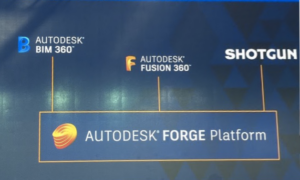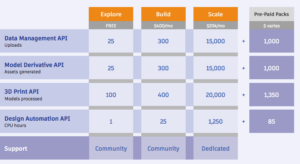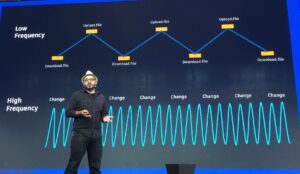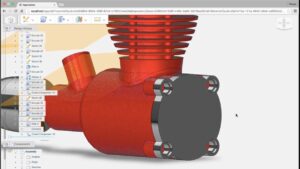Autodesk has been busy planning for a future in the cloud. Its new Forge platform introduced at Autodesk University in 2015 and officially launched on June 16 at San Francisco’s Ft. Mason is a major part of Autodesk’s plans.
Autodesk gathered over 1,000 cloud attendees to its first Forge DevCon event. Most of the attendees were developers, many were Autodesk partners and quite a few were Autodesk employees.
So, what is the Forge Platform? Introduced last year at Autodesk University by Senior Vice President Amar Hanspal as the start of Autodesk’s focused, and coordinated march to the cloud. This year, Hanspal told the audience that Forge is a development platform for the cloud ecosystem. Autodesk is making the same APIs and SDKs available to third party developers as are used by Autodesk’s in-house development team to develop Autodesk’s products. To demonstrate the types of tools that could be created with Forge, Hanspal showed a shoe configurator based on Autodesk’s CAD technology. The idea is that not only can the tennis shoe be spec’d out and designed but it can be sent directly to manufacture.

This year at DevCon, Autodesk was ready to get down into the code with developers and spell out how its plans for the technology and recruit partners and customers.
The first batch of APIs that Autodesk is making available for developers reflects suggest the kinds of apps Autodesk expects developers to build first. They are:
- Viewer – Displays 2D and 3D design files and associated data from 50+ file formats. Enables comments, markup and measurement and supports web and mobile viewing.
- Model Derivative API – Translation technology enabling design files to be viewed online. It also extracts geometry data which can be passed to other applications.
- Design Automation API – Allows developers to run AutoCAD scripts on the Cloud. In addition to working as a drawing generation engine, it can also do fast batch-conversion of DWGs to PDFs.
- Authentication – Open standard used across the Forge Platform for authentication and authorization. Enables access to data to perform specific functions.
- Data Management API – Manages data across A360, Fusion 360, BIM 360 Docs, and the Forge native Object Storage Service. This API allows users to upload and download a data file from different Autodesk products through one consistent and unified interface.
- 3D Print API – Enables developers to quickly build customized 3D printing solutions from 3D print preparation to print management. The API includes tools for mesh repair or slicing. Models can be delivered to 3D printers with remote monitoring and production management.
- Reality Capture API – Extension of Autodesk’s photogrammetry technology enabling series of photographs to be turned into 3D models. Geotagged data from UVAs and drones can be used to create a geo-located orthographic view and the information can be made accessible via Autodesk’s Cloud services or third party programs and can be used in web apps or on desktops.
- Autodesk in-product integration for A360, Fusion and BIM 360 APIs will continue to be available for developers to create new experiences and services that enhance product design, collaboration and construction industry workflows.

What will you do with it?
Autodesk has been soliciting early adopters in the Forge community to apply for Autodesk’s investment awards through the Autodesk Forge Fund. At the conference the group revealed the first three winners. They represent developers working with digital reality, additive manufacturing, and IoT, three hot buttons for the company and for design in general.
The winners are:
3D Robotics (3DR), headed by Chris Anderson. At ForgeDevCon, Anderson talked about how he embarked on 3DR and his experiments with building robots as a way to engage his kids in 2007. Today, he says the drones, flying robots, are undoubtedly cool, but they’re beside the point. The point is to capture and transform visual data into information that can be put to work in a variety of fields including construction, survey, mapping, telecom, etc.
3D Robotics is working with Forge’s Reality Capture APIs to turn captured photos into workable models and engineering data.
MakeTime, described at ForgeDevCon as “AirCnC”, MakeTime sells spare time on subtractive manufacturing machines. This enables machine shops to optimize their investment on their equipment. MakeTime matches projects from buyers to production hours available in shops. MakeTime is taking advantage of Fusion 360 and the Forge View, Data Management API, and Model Derivative API.
Seebo, a simple drag and drop design tool for IoT products. The company says it can be used to create prototypes or even design products. Customers can drag and drop components such as sensors, Bluetooth, accelerometers, GPU, etc. onto a product design framework to transform designs into smart technology. Seebo is working with Forge through Fusion 360 and Fusion Connect.
Data Centric
On day one of Forge, Ben Cochran, Senior SW Architect at Autodesk was described as one of the godfathers of Forge. Cochran told the audience, that the technology world is moving from the era of product to the era of data. Data is the interface for data, he said. And he said, freeing the data will have the same network effect that we’ve already experienced through Internet Protocols, Cat5, TCIP, WiFi, etc. In other words, as more connections are made through the vast, interconnected cloud, data flow more freely. Opening the portals wide to the Internet of Things via the tools used to create things or the things used to capture data.
Significant work in Forge has been done by the Lagoa team acquired by Autodesk last year and headed by Thiago Costa. At Forge this year, Costa outlined the real nature of the revolution Autodesk is building.
The goal for Forge is to move Autodesk into the era of live data. For instance, says Costa data must be freed from the application-based binary silos it now lives in – files and formats. Because that data must then be translated, transported, saved, and killed in static file formats – it’s no longer associated with the process in which it was created.

Costa describes it as the difference between low frequency data and high frequency data. As an illustration, Costa showed Project Leopard, an evolution of Fusion 360. It makes Fusion 360 a full browser product. Costa says, Project Leopard is an example of a high frequency CAD product. Users work with data and they are collaborating on the same data. There will be allowances for branching the data so work can be done simultaneously and that branched data can be brought back into the main stream of data. No one at Autodesk seems interested in saying it this way, but the approach is similar to what OnShape is doing.
Costa’s team started this work at his company Lagoa, which had already built online rendering tools and had embarked on a cloud-based design tool. That’s when Autodesk bought Lagoa.
There was a real feeling of Autodesk getting back to its roots. Autodesk’s longtime head of developer relations Jim Quanci, was the MC of the event. Autodesk grew on the backs of its strong developer and dealer network. Often, they were the same—vendors adding value by creating custom tools. These days Carl Bass is telling dealers that the evolution of the cloud is changing the dynamics for vendors. Increasingly, they’re going to have to add value to maintain relevancy and to differentiate. The opportunities for developers could broaden as the definition of application expands to include modules for Autodesk’s customers’ customers.

What do we think?
It’s interesting to see the ways in which companies are going about the major revolutions being ushered in by the Cloud and IoT, one of the natural consequences of being connected everywhere. It’s fair to say almost all technology companies are going to have to come to grips with this change, which is being called the 4th industrial revolution but in the CAD/PLM worlds companies are choosing their directions. PTC is primarily putting its hooks into the things. Autodesk is building around the design data.
Maybe it doesn’t even matter, it’s all about the data and eventually everything else is just levers and switches and gears for working with the data and disappears into the background. – K.M.





